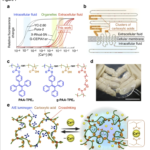Bioinspired design of a polymer gel sensor for the realization of extracellular Ca2+ imaging
Although the role of extracellular Ca2+ draws increasing attention as a messenger in intercellular communications, there is currently no tool available for imaging Ca2+ dynamics in extracellular regions. Here we report the first solid-state fluorescent Ca2+ sensor that fulfills the essential requirements for realizing extracellular Ca2+ imaging. Inspired by natural extracellular Ca2+-sensing receptors, we designed a particular type of chemically-crosslinked polyacrylic acid gel, which can undergo single-chain aggregation in the presence of Ca2+. By attaching aggregation-induced emission luminogen to the polyacrylic acid as a pendant, the conformational state of the main chain at a given Ca2+ concentration is successfully translated into fluorescence property. The Ca2+ sensor has a millimolar-order apparent dissociation constant compatible with extracellular Ca2+ concentrations and exhibits sufficient dynamic range and excellent selectivity in the presence of physiological concentrations of biologically relevant ions, thus enabling monitoring of submillimolar fluctuations of Ca2+ in flowing analytes containing millimolar Ca2+ concentrations.
Learn about our two Decals!
 Click here to find out more about our Fall Bioinspired Design Decal and our Spring Bioinspired Design in Action Decal – ALL MAJORS are welcome.
Click here to find out more about our Fall Bioinspired Design Decal and our Spring Bioinspired Design in Action Decal – ALL MAJORS are welcome.Berkeley BioDesign Community
 Click here to learn about the BioD: Bio-Inspired Design @ Berkeley student organization or here to signup for more info.
Click here to learn about the BioD: Bio-Inspired Design @ Berkeley student organization or here to signup for more info.Search
Student Login




I imagine that the neurological circuits underlying these processes are governed by both 2d spacing maps with their brains as…
to reduce the impact of car accidents, it may be possible to study the force diverting physics of cockroaches to…
you see this type of head-bobbing stability in many avian creatures related to pigeons like chickens. the head ability to…
not like they taught horses how to run! this is an example of convergent evolution where both sea creatures and…
The brain functions in a similar way with neuronal connections. our brains are able to utilize the multiplicity of connections…